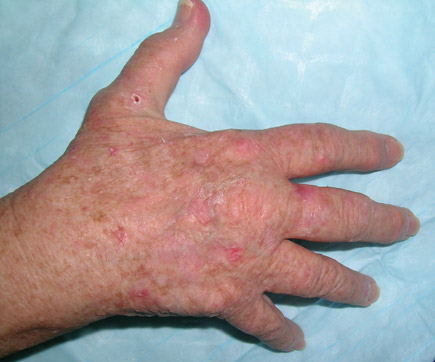MKSAP Quiz: Multiple areas of scaling
A 62-year-old woman is evaluated for multiple areas of scaling and rough skin on her forehead and cheeks, the backs of her hands, and forearms. These areas are painless but persist despite application of moisturizer. She is in good overall health and takes no medications. She has a history of multiple sunburns.
On physical examination, vital signs are normal. Skin findings are shown.

The remainder of the physical examination is unremarkable.
Which of the following is the most likely diagnosis?
A. Actinic keratosis
B. Seborrheic keratosis
C. Squamous cell carcinoma
D. Superficial basal cell carcinoma
Answer and critique
The correct answer is A: Actinic keratosis. This question can be found in MKSAP 17 in the Dermatology section, item 1.
This patient has actinic keratoses (AKs). AKs are precancerous lesions that generally occur in fair-skinned persons on sun-exposed areas such as the face, dorsal arms, hands, legs, and upper back. They are strongly correlated with cumulative sun exposure; the more sun exposure an individual has had, the more numerous they are. A small percentage of lesions (1% to 5%) may evolve into invasive squamous cell carcinomas. However, they never develop into other types of skin cancer such as basal cell carcinoma or melanoma, although many of the factors that predispose one to develop AKs are also risk factors for these other malignancies. The diagnosis of AKs is generally based on the clinical history and the typical tactile and visual appearance of the lesions; biopsy is not routinely needed. Liquid nitrogen is most commonly used to treat AKs, although other destructive methods (shave removal or curettage) are options, and topical therapies (5-fluorouracil, imiquimod) are often used for extensive disease. Efforts to decrease risk for developing AKs include sun avoidance and diligent use of sunscreen.
Seborrheic keratoses are a benign proliferation of keratinocytes that typically appear as hyperpigmented, well-circumscribed, “stuck on” lesions that most commonly develop on the trunk, upper extremities, and face. This patient's skin lesions are not consistent with this appearance, and their location on the dorsal surface of the hands would be uncommon.
Squamous cell carcinomas (SCCs) are typically larger and present as papules or nodules rather than macules. Also, in immunocompetent persons, it is rare to find multiple SCCs occurring simultaneously. Distinguishing between advanced AKs (also referred to as hypertrophic AKs) and early SCCs can sometimes be challenging. Therefore presumptive AKs that fail to respond to treatment should be biopsied to rule out early SCC.
Superficial basal cell carcinomas (SBCCs) often present as scaly macules and sometimes can resemble AKs. SBCCs tend to be more reddish-violet in color, and in contrast to AKs which are often seen in large numbers, patients typically have only a few of these at any given time.
Key Point
- Actinic keratoses are premalignant, erythematous, scaly macules that occur on sun-exposed areas of older persons with fair skin.



